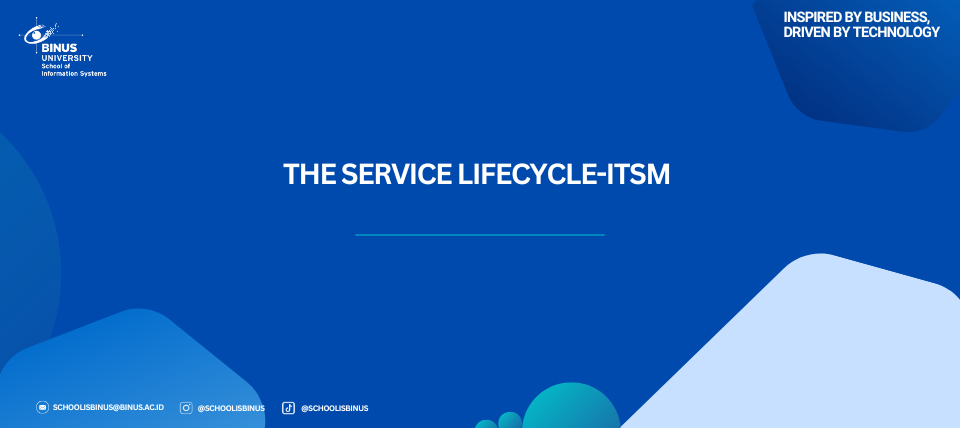THE SERVICE LIFECYCLE-ITSM

The service lifecycle in ITSM describes the stages that a service goes through from its initial conception to its retirement. This typically includes:
- Strategy: Defining the overall approach to service management and aligning IT services with business goals.
- Design: Planning and designing services to meet the needs of the business and its customers.
- Transition: Building, testing, and deploying services into the production environment.
- Operation: Delivering and supporting services on a day-to-day basis.
- Continual improvement: Regularly evaluating and improving services to ensure they continue to meet business needs.
IT Service Management (ITSM) is the way IT teams manage the end-to-end delivery of IT services to customers. This involves all the processes and activities to design, create, deliver, and support IT services.
Key aspects of ITSM
- Customer-centric: ITSM focuses on delivering value to the customer by aligning IT services with their needs and business objectives.
- Process-oriented: ITSM relies on well-defined processes to ensure that services are delivered consistently and efficiently.
- Service lifecycle: ITSM encompasses the entire lifecycle of a service, from strategy and design to transition, operation, and continual improvement.
Core ITSM principles
- People: The skills, roles, and responsibilities of the IT staff involved in delivering services.
- Processes: The workflows and procedures that IT teams follow to manage services.
- Technology: The tools and systems that support the delivery and management of IT services.
Common ITSM processes
- Incident management: Restoring normal service operation as quickly as possible after an unplanned disruption.
- Problem management: Identifying the root causes of incidents and taking steps to prevent them from happening again.
- Change management: Controlling the process of making changes to IT systems to minimize disruption to services.
- Service request management: Handling user requests for information, advice, or standard changes.
- Service catalog management: Maintaining a database of services offered.
- Knowledge management: Sharing knowledge to improve efficiency.
Benefits of ITSM
- Improved IT service quality
- Increased customer satisfaction
- Reduced IT costs
- Better alignment of IT with business needs
- Enhanced IT productivity
- Greater visibility and control over IT services
ITSM frameworks
- ITIL (Information Technology Infrastructure Library): The most widely used framework for ITSM, providing best-practice guidance for IT service management.
- COBIT (Control Objectives for Information and related Technology): A framework for the governance and management of enterprise IT.
IT service management (ITSM) lifecycle
The IT service management (ITSM) lifecycle describes the stages an IT service goes through, from initial planning to retirement. A well-defined lifecycle helps organizations manage services effectively, ensuring they meet business needs and provide value.
While various frameworks exist, ITIL (Information Technology Infrastructure Library) is a widely adopted one that outlines five stages in the service lifecycle:
- Service Strategy
- Purpose: Define the overall direction and objectives of IT services. Align IT strategy with business goals.
- Key Activities:
- Strategy management: Define the approach to service management.
- Service portfolio management: Manage the suite of services offered.
- Financial management: Budgeting, accounting, and charging for services.
- Demand management: Understand and anticipate service demand.
- Business relationship management: Maintain positive relationship with customers.
- Service Design
- Purpose: Plan and design services to meet business requirements and customer needs.
- Key Activities:
- Service catalog management: Create and maintain a catalog of services.
- Service level management: Define service level agreements (SLAs).
- Capacity management: Ensure sufficient capacity to meet demand.
- Availability management: Ensure services are available as agreed.
- IT service continuity management: Plan for service continuity in case of disruptions.
- Information security management: Protect service information and assets.
- Service Transition
- Purpose: Build, test, and deploy services into the production environment. Manage changes to minimize risks and disruptions.
- Key Activities:
- Change management: Control changes to the service lifecycle.
- Service asset and configuration management: Manage service assets and configurations.
- Release and deployment management: Plan, schedule, and control service releases.
- Service validation and testing: Ensure services meet requirements.
- Knowledge management: Share knowledge about services.
- Service Operation
- Purpose: Deliver and support services on a day-to-day basis. Ensure services are delivered effectively and efficiently.
- Key Activities:
- Incident management: Restore normal service operation as quickly as possible.
- Problem management: Identify and resolve the root causes of incidents.
- Event management: Monitor services and respond to events.
- Request fulfillment: Fulfill user requests for services.
- Access management: Grant authorized users access to services.
- Continual Service Improvement (CSI)
- Purpose: Continuously improve the quality and efficiency of services. Identify and implement improvements throughout the service lifecycle.
- Key Activities:
- Service review: Evaluate services to identify improvement areas.
- Process evaluation: Assess the effectiveness and efficiency of processes.
- Definition of CSI initiatives: Identify and plan improvement activities.
- Monitoring of CSI initiatives: Track and monitor the progress of improvements.
#schoolISBinus

